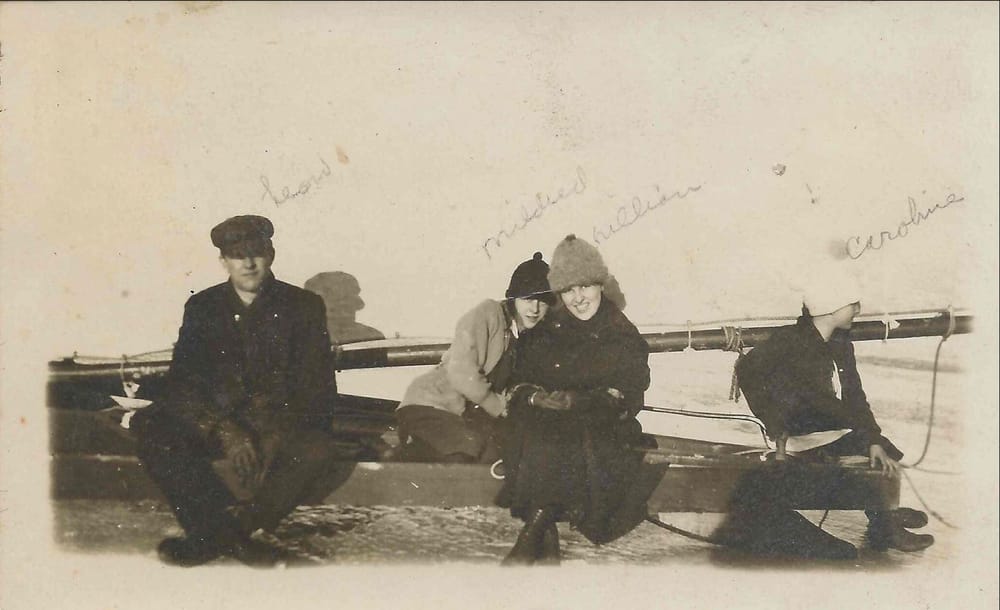An Old Ice Boat
by: Manley L. Rusho
Somewhere around 1943, my cousin John (Dano) and I had a winter project to fix up an old ice boat. We had been working on this old ice boat for several days now, salvaging parts from all over; ropes for steering and supporting the mast, wire swiped from my dad’s electric fence, leftover turnbuckles, nails, screws, and a rope from the Cox’s (neighbor) flagpole.
The ice boat had been in the upper bay all summer, fall, and now winter, exactly where we had left it last spring when the ice went out. We had placed boards under the runners and oiled them to prevent rust. By placing the boards under the runners there was no rotting of the oak wooden runners that were capped with diamond-shaped steel shoes. The shape of the shoe held it to the wood with a V-shaped groove in the wood and the outer side of the diamond gripped the ice.
My guess is that a blacksmith made the steel shoe by getting it red hot and bending the red-hot shoe around the wood runner. Somehow, we had saved the sails, although there were a couple of holes or tears. We had access to any amounts of the canvas sail that was stored on the upper level of my dad’s boat house. Thread and needles were there also, along with a special glue made with powder. The stays that held the mast upright were replaced with electric fence wire. The steering handle was split last year and was now repaired with two pieces of oak spanning the break and held in place with line from a fishing pole, then glued with several coats of glue.
The ice boat was shaped like a triangle with two runners in the front, where the mast was and one runner in the rear. Steering was done from the rear while lying down, mostly with one hand steering and one hand controlling the sail by the sheet rope. The sheet rope was fastened to the boom, the heavy wooden pole that extended from the mast to the rear, parallel to the ground, and beyond the rear of the boat. The mast was only about 12 feet high and was held in place by three pieces of wire that ran from the top of the mast to the frame of the boat.
We were ready to go, but all that we needed was the snow covering the ice to go away. In late January, a rare thaw occurred, a warm weather, odd-ball system, which brought rain. The end of this weather system left the ice clear of snow, and it was a weekend, which also meant no school – so we were good to go!
With the sail up and all aboard, the west wind blowing briskly, we moved out of the shelter of our bay and moved past Bakewell’s dock, out past any shelter, and headed for Clayton. Right away, a mast guide wire came loose; it had been poorly twisted in the turnbuckle. After a quick repair we were away. The ride was fantastic, quite fast, and not too rough, as we went by the old road markers, cedar trees that had marked the first road over the ice bridge to Clayton. Cut cedar trees three or four feet long were placed in holes that were cut in the ice.
Now frozen solid, some trees were standing straight up while others lying down, but still marking the way across the River. Old piles of horse manure also marked the way because they were raised up from the ice as they shielded the snow from melting during the recent rain.
Between Calumet Island and Pine Island, a huge crack in the ice had formed and the ice was heaved up 3 or 4 feet high around it. Perhaps one hundred yards from the crack, John reversed course and started back to Grindstone; we were traveling at a high rate of speed, about 40 or more miles per hour, holding to a course almost straight for Wright’s huge yellow boat house on Grindstone.
Now, the rough ice made the old boat shake like crazy and managed to shake loose some of the boards that we had nailed on the bed in haste. I did my best to secure some of the loose boards with string as we went along – some fell off and some stayed on the boat. About 100 yards from Grindstone, Cousin John changed course to the west, the wind was now blowing northwest and it was too late, we were now heading for Cape Vincent, some 10 miles away!
How we flew, with small bumps on the ice creating a steady, bumpy ride – with an occasional big bump – as we really flew past the head of Grindstone and past the Blanket Shoal. Only the leafless trees marked its location and soon the eastern end of Wolfe Island went by, as we were now heading for Carleton Island and would pass it on the south side. I was half frozen and did not know it because the thrill of the ride was overwhelming awareness of my physical condition.
Not even halfway to Carleton Island, we encountered another big ice crack, and our western progress was blocked. As we turned, the strong wind caused the sails to slap loud and hard, sounding like gun shots. As we stopped, I quickly tried to secure the loose floorboards and we were off again! The 7 or so miles back to Grindstone was a bit boring. Nothing broke or came loose and we sailed into our bay. The shelter from the wind was a blessing, but about halfway into the west end of bay, we were hit by a strong wind gust that blew us straight down the bay.
Fortunately, both of us wore creepers, metal things that attached to the bottom of our shoes and held in place with leather straps; without these creepers, it was impossible to walk on the ice against the wind. We were pushing the boat against the wind, back to the west end of the bay to our boathouse.

I never had another ride quite like that on that ice boat. I had several short rides, but there was too much snow, not enough wind, or too little time to go very far. Nothing like this unforgettable, once in a lifetime, ride. Perhaps John had some other adventures with this ice boat, but not me.
The old boat was eventually absorbed into the mud there in Upper Bay. Over the years, I remember finding the metal shoes from the runners along with a few odd nuts and bolts, a couple of nails well-rusted in pieces of wood, bits of electric fence wire. All reminders of a time when we were as free as the freezing west wind that drove our adventure.
Many years later, I came across an old photo of Uncle Leon (Dano) with some of his sisters, sitting on an iceboat in the 1920’s. I wondered if this was the same boat, and although I have no way of knowing for sure, I’m pretty sure it is,
By Manley L. Rusho
Manley Rusho was born on Grindstone Island nine+ decades ago. Back in 2021, Manley started sharing his memories with TI Life. (Manley Rusho articles) This Editor and his many friends wish him continued good health and we thank him, most sincerely, for sharing - as the life and times on Grindstone Island are special and should never be forgotten.
Editor's Note: January 2023, and Manley you have given us, once again, a lovely article about life on Grindstone. Many islanders remember the ice boats of the St. Lawrence. I am sure this brings back lots of memories.






Please click here if you are unable to post your comment.